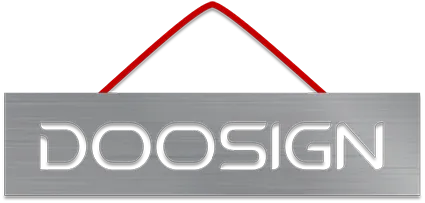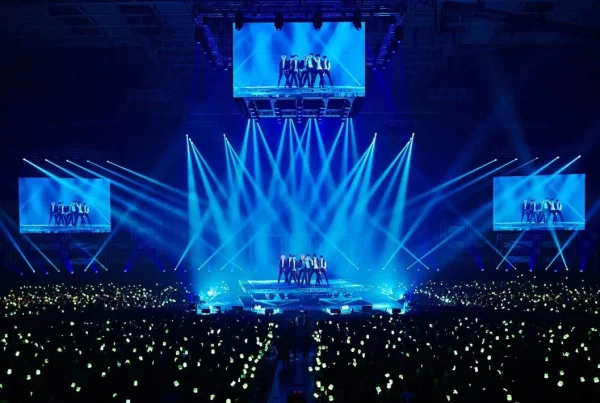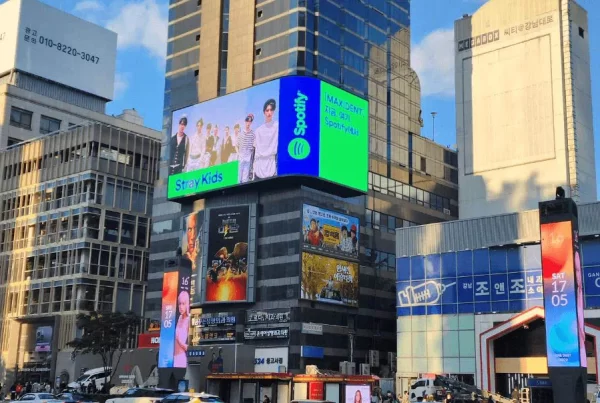
Introduction to LED display
LED display is a new type of imaging electronic device made of light-emitting diodes arranged sequentially. Due to its high brightness, wide viewing angle, long life and other characteristics, it is widely used in outdoor advertising screens and other products.
LED display is generally used to display text, images, video, video signals and other information, not only can set information release, literary entertainment, publicity function for one, and as a new high-tech commodity, with its rich scientific and technological content, surging appearance momentum, smooth display of the picture, delicate color embodiment, can add a new vitality to the environment, set up an activity landscape, has now become the first choice of corporate publicity.
2. LED display principle
The LED display main controller converts the signal of the computer display card into the data and control signal format required by the LED display. The main controller obtains the color brightness data of each pixel of a screen from the computer display card, and then assigns it to a number of scanning boards, each scanning board is responsible for controlling a number of rows/columns on the LED display, and the LED display signal on each row/column is cascaded transmission through the various display control units of the bank in a serial manner, and each display control unit directly faces the LED display body. Display control singles typically consist of shift register latches with grayscale control.
On the one hand, the scan lever accepts the video signal of the main controller, on the other hand, it transmits the data belonging to the level to its own display control unit, and at the same time, the data that does not belong to the level must be transmitted to the next cascaded scan lever. Video signals and LED display data, in space, time, sequence and other aspects of the difference, need to be coordinated by a scanning board.
3. The role of the LED display
- Play the role of product promotion and attracting customers.
- Play the role of store decoration and improve the grade of enterprises.
- Play the role of lighting and unconventional.
- Play the role of popularizing knowledge, which can be used to broadcast small information of enterprise products and knowledge of related industries.
- Play the role of bulletin board, such as promotion, recruitment information release.
- Play a role in setting the atmosphere. Through the display screen, you can play the welcome words of superior leaders and various VIPs to visit and guide, and the celebration words of various major festivals.
4. The use of LED displays
- Business publicity and information display in postal, telecommunications, shopping malls and shopping centers and other service fields.
- Dispatching command center information display, power dispatching. Vehicle dynamic tracking, vehicle height adjustment management, etc., are also gradually adopting high-density LED displays.
- Securities trading, financial information display, LED display in this field accounted for more than 50% of the domestic LED display demand in previous years, there is still a large demand.
- New products of advertising media. In addition to outdoor LED display as advertising media, cluster LED display advertising system, train LED display advertising system, etc. have also been adopted and are being promoted.
- Airport flight dynamic information display. The requirements for accommodation display in the construction of civil aviation airports are very clear, and LED display is the preferred product of FIDS for flight accommodation display system.
- Display of passenger guidance information at port stations. The information system and broadcasting system with LED display as the main body, the train arrival disclosure system, the ticket information system, etc. together constitute the automation system of the passenger transport hub.
- Stadium information display. As the main means of game information display and live broadcast of matches, LED displays have replaced traditional lighting and CRT displays, and have become a necessary game facility in modern stadiums.
- Road traffic guidance information display application display. The rise of Intelligent Efficiency System (ITS) is effective in cities. Motorways and other fields. LED display is widely used as a variable information board, speed limit sign, etc.
- Performances and gatherings. Large LED displays are increasingly used for live video broadcasts for public and political purposes, such as the 50th anniversary of the founding of China. In major festivals such as the New Millennium celebration around the world, large LED displays play an outstanding role in broadcasting live and advertising information.
- Exhibition. As one of the important service contents provided by exhibition organizers, LED display large screen provides paid services to exhibitors.
6. The difference between LED display and LCD display
Simply put , LCD and LED are two different display technologies, LCD is a display composed of liquid crystals, and LED is a display composed of light-emitting diodes.
- The power consumption ratio of LED and LCD is about 1:10, and LED is more energy-saving.
- LED has a higher refresh rate and better performance in video.
- LED LCD screen backlight has a wider color gamut than LCD screen. LEDs provide a wide viewing angle of up to 160°, can display a variety of text, digital, color images and animation information, and can play color video signals such as TV, video, VCD, DVD, etc.
- The reaction speed of a single element of the LED display is 1000 times that of the LCD screen, which can also be taken care of under strong light, and adapt to a low temperature of minus 40 degrees.
7. LED display installation
LED display is divided into a variety of installation methods according to different application fields, and the following are 11 common ones:
- Wall-mounted : usually used indoors or semi-outdoors, the screen display area is small, and generally does not leave maintenance channel space. The screen body area is slightly larger, generally using the front maintenance design, using the column assembly method.
- Column type : there are a variety of them, generally used for outdoor advertising. Single columns are suitable for small screen applications, double columns are suitable for large screen applications, closed maintenance channels are suitable for simple boxes, and open maintenance channels are suitable for standard boxes.
- Cantilever type : mostly used indoors and semi-outdoors, the screen design generally adopts integrated cabinet design, or hoisting structure design.
- Hanging type : similar to the cantilever installation method, the application is the same, the screen body adopts an integrated cabinet design scheme, suitable for indoor and semi-outdoor screen body.
- Inlay : indoor and outdoor use, but the general application and small dot distance and small display area of the screen, mostly used in the door of the building, building hall, etc., generally the entire display body embedded in the wall.
- Standing : the main typical application LED TV design, generally using integrated cabinet design, there is also a separate combination design, suitable for indoor small dot pitch specification screen body, generally small display area.
- Roof type : generally installed with an inclined angle, or the module adopts an oblique 8° design, mostly used for outdoor advertising display.
- Football field fence type : the viewing angle of the display body can be adjusted with the slope of the support frame, and soft silicone mask and soft arc top design are adopted.
- Rental hoisting type: the size of the screen is determined by ordinary screen, the general requirements are below 6M*10M, and the lifting mechanism is divided into: gear type, cone rod type, bolt type.
- Arc form : The length of the picture can be preliminarily determined by the circumference of the circle or arc. Divide by the module length to determine the number of modules.
- Truss mobile type : it adopts truss guide rail design, which is generally used in the stage background screen body, mostly used in TV stations, concerts and other scenes, and the screen body can be moved in real time according to actual needs.
8. LED display repair
One unit board does not light up:
There is no +5V, indicating that the power supply is bad, replace the power supply; 2. The data cable is bad, replace the data cable.
The whole screen does not light up
The main controller does not have +5V, indicating that the power supply is bad, replace the power supply; 2. The whole screen AC power is not available, and the power supply circuit can be checked; 3. The computer settings are not correct, reset them.
A cell is solid red (or green).
If there is a problem with the data cable connected to this unit, plug the data cable again and pay attention to the direction; 2. If there is a problem with the corresponding distribution board, you can change a data line; 3. If a fast unit board fails, the distribution board can be replaced;
Communication is not normal
If the software is not set correctly, you can restart the computer and re-open the display screen; 2. The communication line is not connected, and it is set again; 3. There is a problem with the MAX323, use a digital meter to measure, and there is a problem to replace this MAX232.
The whole screen is lit horizontally by a few lines, and not lit up after a few lines
The network cable is not plugged in, and it can be solved by plugging the network cable well.
The large screen display is normal, and the computer screen is black
The computer settings are incorrect, reset it.
The information on the first few screens is normal, and the last few screens are not normal
The capacity of the screen is limited, too many messages are sent, re-send, minus some unnecessary information; 2. The memory device is not erased and resent.
The information is correct, but the font is missing strokes
The size of the information and the size of the screen are inconsistent, redo the information, the size to be set and the size of the screen are consistent.



